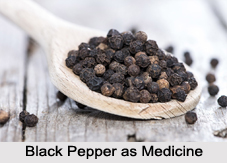 Piper Nigrum is the botanical name of Black Pepper. The use of black pepper as a condiment is well known. Medicinally it is much used in combination with long pepper and ginger, under the name of "Trikatu" or the three acrids.
Piper Nigrum is the botanical name of Black Pepper. The use of black pepper as a condiment is well known. Medicinally it is much used in combination with long pepper and ginger, under the name of "Trikatu" or the three acrids.
Health Benefits of Black Pepper
Black pepper is described as acrid, pungent, hot, dry, carminative and useful in intermittent fever, haemorrhoids and dyspepsia. Externally it is used as a rubefacient in alopecia and skin diseases.
Dose of Black Pepper in Medicine
In intermittent fever, black pepper in doses of about a drachm is recommended to be given with the juice of the leaves of Ocimum sanctum (Tulsi) or Leucas linifolia (dronapushpi). It enters into the composition of numerous prescriptions for dyspepsia, piles and indigestion.
Pranada Gudika: Take black pepper 32 tolas, ginger 24 tolas, long pepper 16 tolas, Piper Chaba (chavya) 8 tolas, leaves of Pinus Webbiana (talisa) 8 tolas, flowers of Mesua ferrea, (nagakesara) 4 tolas, long pepper root 16 tolas, leaves called tejapatra and cinnamon 1 tola each, cardamoms and the root of Andropogon muricatus (usira) 2 tolas each, old treacle 240 tolas; rub them together. Dose should be about 2 drachms. This confection is given in haemorrhoids. When there is costiveness and a sense of heat, chebulic myrobalan is substituted for the ginger in the above prescription.
The bald patches of alopecia are recommended to be rubbed with some rough leaves as of Streblus asper (sakhota) and then sprinkled over with powdered black pepper.
This article is a stub. You can enrich by adding more information to it. Send your Write Up to content@indianetzone.com
Related Articles
Ayurveda
Sushruta Samhita
Classification of Medicine
Properties of Material Objects and its Effect on Human Body
Indian Herbs
Traditional Indian Medicines




















